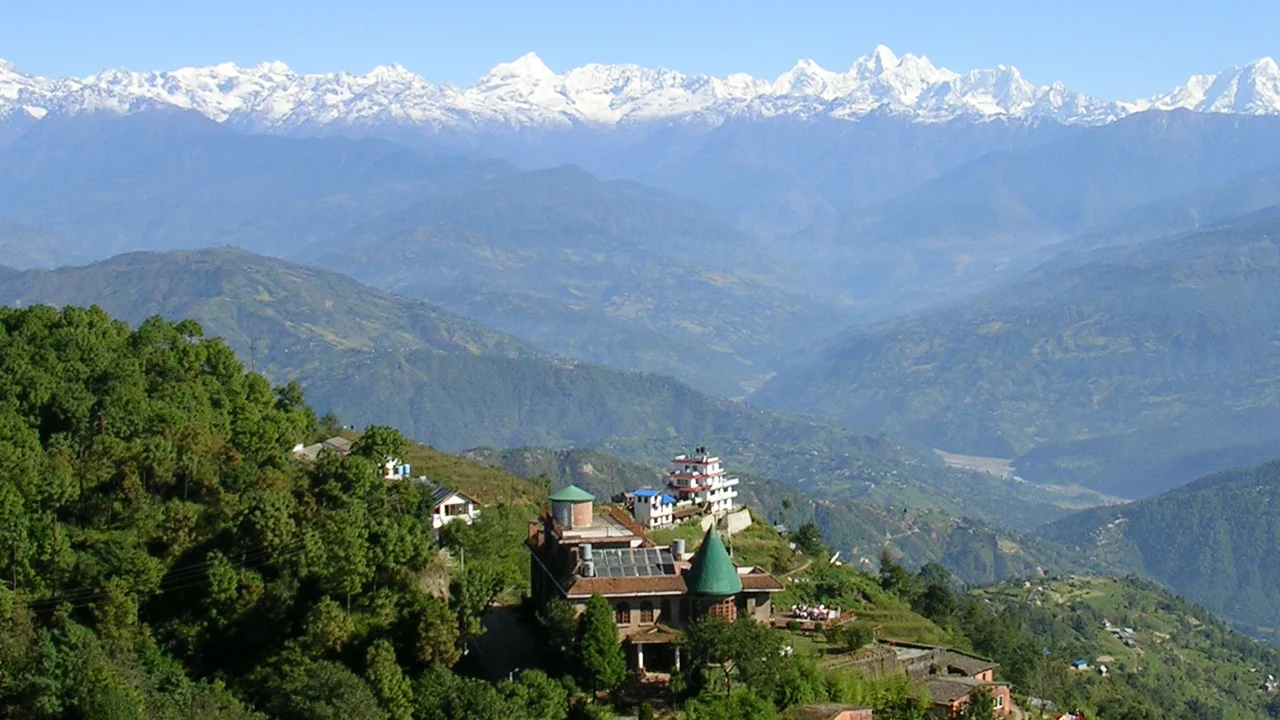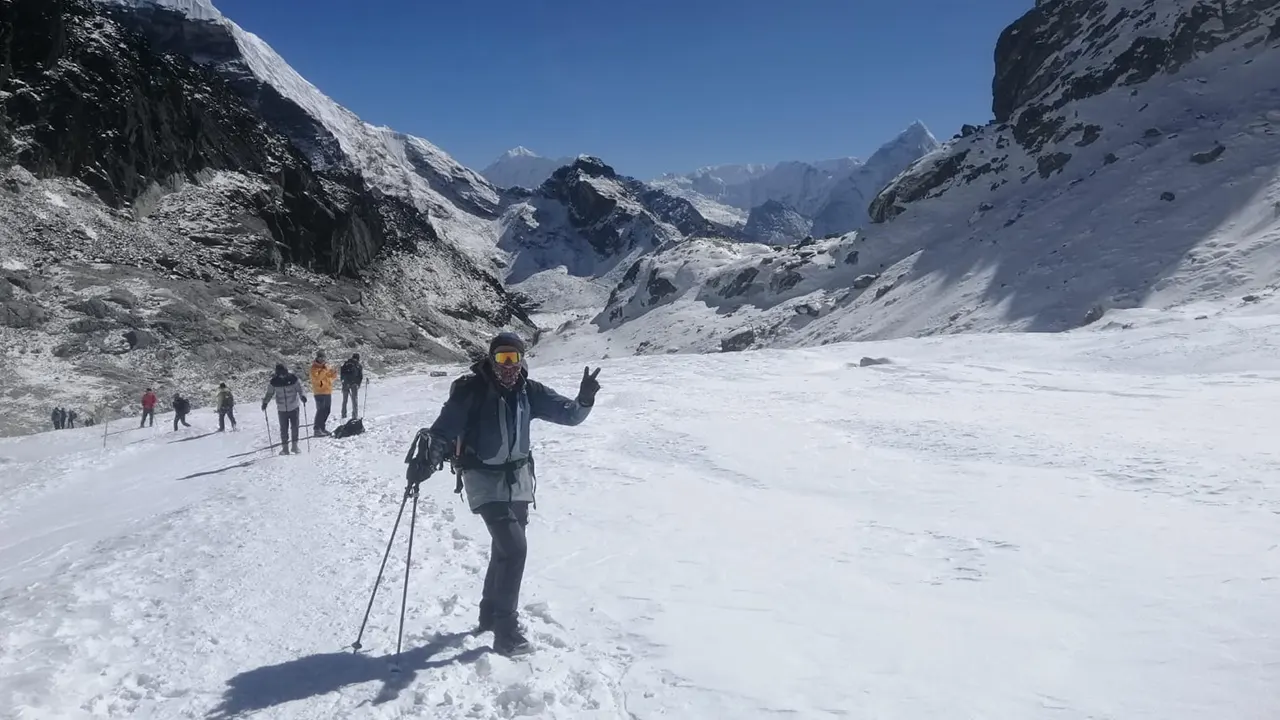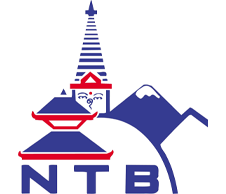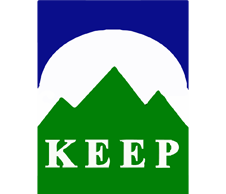Your adventure begins with a scenic drive from Kathmandu to Beni. The journey takes you along the winding Prithvi Highway, following the Trisuli and Marsyangdi Rivers with views of terraced hillsides, green valleys, and bustling roadside settlements. After reaching Pokhara, a change of vehicle takes you deeper into western Nepal toward Beni, the starting point of the trek. This town sits at the confluence of the Myagdi Khola and Kali Gandaki rivers and offers the first glimpses of the mountains ahead. Tonight, you’ll rest in a tea house and prepare for the trek. Carry snacks and hydrate well during the long drive, as food options along the way are basic.
Dhaulagiri Round Trek – 16 Days
Overview
The Dhaulagiri Round Trek is one of Nepal’s most adventurous and challenging journeys, circling the mighty Mount Dhaulagiri (8,167m), the world’s seventh-highest peak. Unlike the popular trails of Everest or Annapurna, this trek ventures deep into remote valleys, high alpine passes, and rugged glaciers, offering a rare sense of wilderness that few trekkers ever experience.
The route begins in the lush foothills near Beni, where terraced farmlands and traditional Magar and Gurung villages welcome you with warm hospitality. As you ascend higher, the landscapes quickly transform—from subtropical forests into alpine meadows, icy glaciers, and dramatic high passes. Trekking through this region provides a unique opportunity to see both the natural and cultural richness of Nepal in one journey.
One of the main highlights is reaching Dhaulagiri Base Camp (4,740m), where towering ice walls and glaciers surround you on all sides. From here, the adventure intensifies with the crossing of French Pass (5,360m) and Dhampus Pass (5,200m). These challenging sections test your endurance but reward you with sweeping views of Dhaulagiri, Annapurna, Nilgiri, and Tukuche peaks. Beyond the passes lies the mystical Hidden Valley, an isolated world of barren landscapes and silence, giving the trek its reputation as one of Nepal’s most secluded adventures.
Because of its difficulty and remoteness, the Dhaulagiri Round Trek is best suited for experienced trekkers with prior high-altitude trekking background. Accommodation is a mix of tea houses and camping, especially in the higher sections where settlements are rare. A full support team with guides, porters, and cooks ensures safety and comfort throughout the journey.
This 18-day trek is not just about physical challenge—it’s a true Himalayan expedition. With fewer trekkers on the trail, you’ll enjoy a sense of solitude rarely found in Nepal’s busier trekking regions. If you are looking for an off-the-beaten-path adventure that combines culture, wilderness, glaciers, and high passes, the Dhaulagiri Round Trek is one of the finest options.
Highlights of Dhaulagiri Round Trek
- Circle around Mount Dhaulagiri (8,167m), the world’s seventh-highest mountain.
- Trek through remote villages, forests, and valleys rarely visited by other trekkers.
- Cross challenging high passes including the French Pass (5,360m) and Dhampus Pass (5,200m).
- Camp on the dramatic Dhaulagiri Base Camp, surrounded by glaciers and towering peaks.
- Witness stunning contrasts of subtropical farmland to high alpine landscapes.
- Explore the wild Hidden Valley, a remote Himalayan sanctuary.
- Experience authentic Gurung, Magar, and Thakali culture along the trail.
- Enjoy panoramic views of Dhaulagiri, Annapurna, Nilgiri, and Tukuche peaks.
- A true adventure trek for experienced hikers seeking challenge and solitude.
- Less crowded and more remote compared to Everest and Annapurna treks.
The trail follows the Myagdi Khola River through subtropical forests, terraced farmland, and scattered villages. You’ll cross suspension bridges draped with prayer flags and pass locals working in the fields. The walk is gentle, giving you a chance to soak up rural Nepali life away from the noise of traffic. Babiachaur is a peaceful riverside village surrounded by paddy fields and lush hills. Tonight, you’ll stay in a tea house where simple yet hearty Nepali meals such as dal bhat (lentil soup with rice) are served.
Today’s trek ascends gradually through terraced slopes and into dense forests of alder, bamboo, and oak. Traditional Magar villages appear along the trail, where children often greet trekkers with cheerful “namaste.” Watch for water buffalo grazing quietly and villagers carrying baskets of crops. The trail alternates between stone-paved stretches and earthy forest paths. Dharapani lies on a serene river bend, surrounded by green hills. Tea house accommodation here is basic but warm, and you’ll likely enjoy a local curry or noodle soup before turning in.
Leaving Dharapani, the trail climbs steadily, crossing rivers and forests before reaching the ridge-top village of Muri. Along the way, views of Dhaulagiri’s snow-capped peaks begin to dominate the horizon. Muri is inhabited mainly by Magar people, one of Nepal’s oldest ethnic groups, known for their hospitality and rich traditions. Spend time exploring narrow alleys, terraced fields, and traditional homes. Dinner is usually a communal affair with dal bhat, vegetables, and perhaps millet bread. Sleep comes easily with the cool mountain breeze and the sound of the river far below.
The day begins with a short climb to a low pass offering fantastic views of Mt. Ghustung South. The trail weaves through pine and oak forests, and soon terraced farmland reappears as you descend into Boghara. From this settlement, you’ll enjoy panoramic views of Dhaulagiri I and Gurja Himal. The atmosphere is quieter, with fewer trekkers and a deeper sense of isolation. Accommodation in Boghara is simple, often with stone-and-wood tea houses where you’ll be served seasonal vegetables, rice, and warm tea by the fire.
The trail grows more rugged today, with a series of ups and downs through forested ridges and cultivated lands. Small clearings like Lipshe provide a scenic spot for a lunch break. As you gain altitude, villages become fewer and the terrain more challenging. Eventually, you’ll reach Dobang, nestled in a forest clearing, surrounded by bamboo and rhododendron trees. Dobang is one of the last semi-permanent settlements before heading into the high alpine regions. Nights here can be colder, so keep your warm layers handy.
Leaving Dobang, the route follows forested trails beside the Myagdi Khola. You’ll cross several wooden bridges and streams, with steep slopes rising on either side. Human settlements become scarce, and the sense of remoteness deepens. Occasional tea stalls may appear, though they are not always open. The day ends at Choriban Khola, a wild and quiet campsite beside the river. Tonight, you’ll likely camp under the stars, with dinner prepared by the trekking crew. Hydration and pacing are important as you move above 3,000 m.
The trail climbs steeply today, entering rocky terrain and glacial moraine. You’ll see the Chhonbarban Glacier and dramatic views of the Dhaulagiri Massif and Tukuche Peak. Loose scree and boulder fields require careful footing. Italian Base Camp is perched on a grassy shelf surrounded by massive snow-clad peaks, a truly breathtaking location. The name is linked to Italian climbers who attempted new routes here in the 1970s. Expect cold temperatures at night, with warm meals and a sense of achievement after the tough climb.
A rest and acclimatization day helps your body adjust before the high passes ahead. You may take a short hike up nearby ridges for better views of Dhaulagiri I and surrounding peaks. The day is also a chance to journal, chat with locals, or photograph the spectacular landscape. Staying active with light walks is recommended, but avoid overexertion. Your crew will prepare warm meals and hot drinks throughout the day. Nights here can drop below freezing, so keep sleeping bags zipped and gear ready.
A challenging day takes you through a glacial moraine with steep rocky sections. The narrow, canyon-like trail requires careful steps, especially over loose scree. Along the way, you’ll pass the Swiss Base Camp and gain views of Chhongardan Glacier, Dhaulagiri, and Manapathi Peak. Glacier Camp lies on a rough, icy plateau surrounded by towering walls of snow and ice. Tonight, you’ll camp in a stark, dramatic environment where temperatures are much colder. Ensure your water bottles are insulated to prevent freezing.
This section ascends steep moraines with expansive views of Tukuche Peak and Dhaulagiri’s towering walls. The valley gradually widens, and prayer flags signal your arrival at Dhaulagiri Base Camp. Here, you are completely surrounded by 7,000–8,000 m peaks: Dhaulagiri I, II, III, and V dominate the skyline. The campsite is open and exposed, so strong winds and cold nights are common. Dinner is served in the mess tent, often followed by stargazing in one of the most incredible mountain amphitheaters on Earth.
Another vital acclimatization day before tackling French Pass. Explore the glacier edges or hike short ridges for better panoramas. Resting here helps the body adjust to thinner air, reducing the risk of altitude sickness. Meals are simple but warm—often soup, rice, or noodles—prepared by the trekking crew. Nights are extremely cold, so keep multiple thermal layers inside your sleeping bag. This is also a perfect day for photography, as the light on Dhaulagiri’s icy faces changes dramatically throughout the day.
Today is one of the trek’s toughest but most rewarding days. The trail climbs steadily over glacial moraine to French Pass (5,360 m / 17,585 ft), where prayer flags flutter against a backdrop of Tukuche Peak, Dhaulagiri I, and Sita Chuchura. The descent into Hidden Valley brings you to a remote grassy plateau at 5,200 m. Hidden Valley is stark yet beautiful, often snow-covered, and it’s one of the coldest campsites of the trek. Tonight’s camping experience here is unforgettable, with vast skies and towering peaks all around.
Crossing Dhampus Pass (5,240 m / 17,191 ft), the second high pass of the trek, the trail rewards you with panoramic views of Annapurna, Nilgiri, and the Kali Gandaki Valley. The descent is long and steep, but the air becomes thicker and warmer as you lose over 1,500 m in altitude. Yak Kharka is a pastureland dotted with stone huts, often visited by herds of grazing yaks. Though still high altitude, you’ll feel relief from the harsh cold of Hidden Valley. Camping here is more comfortable, with easier breathing and better rest.
A steep descent leads you into pine and rhododendron forests before reaching the apple-growing village of Marpha. After many days in remote highlands, Marpha feels lively with its whitewashed homes, cobblestone lanes, and Buddhist monastery. This picturesque settlement along the Kali Gandaki River is famous for apple orchards, cider, and apple brandy. You’ll stay in a comfortable tea house with access to WiFi—an excellent chance to reconnect with family. Enjoy a warm Nepali or Tibetan meal before resting in this beautiful village.
The trek concludes with a drive from Marpha down the Kali Gandaki Valley toward Pokhara. The road follows deep gorges, waterfalls, and views of Annapurna and Nilgiri ranges fading in the distance. Once in Pokhara, you can celebrate the completion of the Dhaulagiri Circuit with a lakeside stroll along Phewa Lake. Hotels in Pokhara provide modern comforts—hot showers, soft beds, and international meals—that feel luxurious after weeks in the mountains. This is a fitting end to one of Nepal’s most challenging and rewarding treks.
Cost Includes
- All required trekking permits including Annapurna Conservation Area Permit (ACAP) and TIMS card
- 3-star hotel accommodation in Kathmandu and Pokhara with breakfast
- Full-board meals (breakfast, lunch, dinner) during the Dhaulagiri Round Trek
- Accommodation in tea houses or tents along the trekking route
- Domestic transfers as per itinerary (private vehicle, bus, or jeep)
- An experienced English-speaking guide and necessary number of porters with their salary, meals, equipment, and insurance
- Complete camping equipment (tents, kitchen gear, cooking staff, etc.) for remote sections of the trek
- First aid medical kit carried by the guide
- Welcome and farewell dinners in Kathmandu
- All government taxes and official service charges
Cost Excludes
- International flights to/from Nepal
- Nepal visa fee on arrival
- Personal trekking gear (down jacket, sleeping bag, boots, etc.)
- Extra nights in Kathmandu or Pokhara due to early return, flight cancellations, or delays
- Meals and drinks in Kathmandu/Pokhara (outside of the included meals)
- Personal expenses: hot showers, snacks, internet, charging, bottled water, laundry
- Travel and medical insurance (must include high-altitude rescue coverage)
- Emergency evacuation costs (if required)
- Costs due to unforeseen circumstances such as weather delays or natural disasters
- Tips for guides, porters, and staff (voluntary but highly appreciated)
FAQs
The Dhaulagiri Round Trek is considered one of the most challenging treks in Nepal. It involves long trekking days, steep ascents and descents, glacier walking, and crossing high passes like French Pass (5,360m) and Dhampus Pass (5,200m). You need to be physically fit, mentally prepared, and have previous high-altitude trekking experience. It is recommended only for experienced trekkers seeking adventure in remote regions.
The best seasons are spring (March to May) and autumn (September to November). During these months, the weather is generally clear, offering excellent mountain views and safer trail conditions. In spring, you’ll also enjoy blooming rhododendron forests, while autumn brings crisp skies after the monsoon. Winter and monsoon are not suitable due to heavy snow and landslides.
Yes, prior trekking experience is highly recommended. The Dhaulagiri Round Trek is physically demanding and involves trekking above 5,000m, camping in remote areas, and walking on glaciers. Previous experience in high-altitude treks such as Everest Base Camp, Annapurna Circuit, or Manaslu Circuit is very helpful. Without some experience, it may be too difficult for first-time trekkers.
Accommodation during this trek is a mix of tea houses and camping. In lower sections, basic tea houses provide simple lodging and meals. In higher and remote areas, camping is necessary. Your trekking company will provide tents, kitchen equipment, and staff to set up camps. The camping experience is rustic but rewarding, offering a true Himalayan adventure.
On average, you will trek 6–8 hours per day. Some days may be shorter, but high pass days like French Pass and Dhampus Pass can take up to 9–10 hours. The pace is steady with frequent breaks for meals, acclimatization, and photography. Because of the demanding terrain, trekkers are encouraged to walk slowly and conserve energy.
Yes, acclimatization is crucial. The Dhaulagiri Round Trek reaches elevations above 5,000m, where altitude sickness can be a real risk. The itinerary includes acclimatization days to allow your body to adjust gradually. Drinking plenty of water, eating well, and trekking slowly are important to minimize the risk of altitude-related issues.
Trekkers need the following permits:
-
Annapurna Conservation Area Permit (ACAP)
-
TIMS Card (Trekkers’ Information Management System)
These permits are arranged by your trekking agency before the trek. Since the route passes through restricted and conservation zones, having proper documentation is mandatory.
During the tea house sections, meals include traditional Nepali dishes like dal bhat, noodles, soups, fried rice, and Tibetan bread. During camping days, the trekking crew prepares fresh meals with a mix of Nepali, Indian, and continental food to keep energy levels high. Hot drinks such as tea, coffee, and soup are provided regularly. Vegetarian options are always available.
The trek offers incredible highlights such as:
- Circling Mount Dhaulagiri (8,167m), the world’s seventh-highest peak
- Crossing French Pass and Dhampus Pass, two of Nepal’s highest trekking passes
- Exploring the remote Hidden Valley
- Trekking through Dhaulagiri Base Camp, glaciers, and rugged mountain terrain
- Experiencing authentic Magar, Gurung, and Thakali culture in remote villages
- Enjoying panoramic views of Dhaulagiri, Annapurna, Nilgiri, and Tukuche peaks
This combination of culture, wilderness, and high-altitude adventure makes it a once-in-a-lifetime trek.
Because of its remote trails and technical sections, this trek is not recommended for solo trekkers. It is best done with a licensed trekking guide, porters, and a support team who handle camping, food, and navigation. Solo trekking in this region is risky due to unpredictable weather, high passes, and lack of facilities. Joining a group or hiring a professional guide is strongly advised.
Dhaulagiri Round Trek – 16 Days
Trekking & Hiking Adventure





